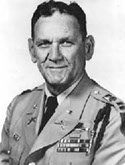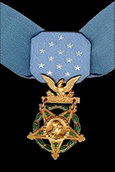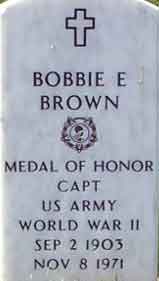




Personal Information
Bobbie (Robert) Evan Brown Jr. was born on September 9, 1903 in Dublin, Georgia. He entered military service in Atlanta, Georgia. He died on November 8, 1971 in Highland Falls, New York. After World War II he worked in the maintenance department at the U. S. Military Academy.
Medal of Honor Event
By the time World War II began, he was the first Sergeant in the Headquarters Company of Patton's 2nd Armored Division. After fighting across North Africa, he received battlefield promotion to Second Lieutenant and transferred to the 1st Infantry Division. He led a platoon of Company C up Omaha Beach on D-Day. In fighting across France, his Company Commander was killed and he was given command. A Few days later the promotion became official.
At 4 am, October 8, 1944, he received orders for an attack on Crucifix Hill. Of 43 known pillboxes and bunkers, his company was responsible for numbers 17, 18, 19, 20, 26, 29, and 30. After a flight of P-47 Thunderbolts finished an air strike at 1:15 pm, he led his company out of positions in a graveyard at the foot of the hill. They made it about 150 yards to an antitank ditch in front of pillbox 18 before heavy German fire forced them to seek cover. He turned to his platoon Sergeant, "Get me a couple of flamethrowers, some pole and satchel charges." Once armed with those, he had his riflemen lay down a base of fire. Then he started crawling alone toward the pillbox. A bomb had blown a big crater alongside the pillbox. He jumped into it and prepared to drop a satchel charge through an aperture by a door. While he worked, a German soldier suddenly stepped out of door. He instantly leaped forward and struck the man in the face with roundhouse punch. The young soldier dropped limply inside the door. He hurled in a satchel charge, slammed the steel door shut, then dove headfirst back into the crater. The pillbox erupted, huge clouds of smoke billowing from its rifle ports. One down.
He wriggled his way back to his men, picked up some more charges, then went back uphill 35 yards past the still smoking bunker and toward number 19. Machine-gun bullets zipped past within inches of his head. Several mortar rounds crashed nearby, slamming his body to the ground. Under his company's covering fire he pushed forward. Snaking behind the concrete structure, he shoved a pole charge through a 12-inch opening. That blew a gaping hole in the pillbox. For good measure, he tossed in a satchel charge. That took care of any survivors. On his way back downhill for more charges, he noticed blood covering one knee. Then his Sergeant told him, "Sir, there's bullet holes in your canteen." He had no idea when he'd been hit.
Pillbox 20 was largest and most heavily armed fortification on the hill. A turret, mounting a cut-down 88-mm, revolved 360 degrees on top. Walls were 6-feet of concrete. No less than 6 machineguns poked their barrels through firing ports. Later it would be learned that 45 Germans manned the structure. He had no idea how he'd knock it out, but he'd try. He followed a communications trench 20 yards from number 19 to 20. He studied the apertures, trying to decide which one to stuff a pole charge in, when nearby movements caught his eye. A German soldier was entering bunker via a steel door, his arms filled with ammunition. As the German disappeared through the door, he acted. He lunged forward, pulled door open, threw in 2 satchel charges, and dove for cover. Just as he landed on his face, the pillbox erupted. With the destruction of pillbox 20, enemy resistance on Crucifix Hill crumbled. All that remained was mopping up. His assault secured the 1st Division's flank.
After the hill was secure, he went alone on a reconnaissance mission to locate enemy troops beyond the hill. Without regard for his own safety, he purposely drew enemy fire to locate enemy emplacements. During this reconnaissance mission, he was wounded twice more. However, the information he discovered about German emplacements allowed his company to repel two German counterattacks. Only after the position was completely secure did he allow treatment for his wounds.
He was also wounded during street fighting in Aachen when an artillery shell landed practically beside him. Numb, blood streaming from his nose, ears, and mouth, he headed for an aid station. He spent several months in a hospital in Belgium, then went home on 30-day leave. He rejoined Company C in Germany and fought with it into Czechoslovakia.
ArlingtonCemetery.net


Service Record
Bobbie E. Brown was a rough-hewn Southerner who had been born in poverty, and had been an enlisted man for more than twenty years when he won a battlefield commission in World War II. He was a Captain in command of the 18th Infantry Regiment’s “Charlie” Company when he performed the actions that resulted in his Medal of Honor recognition.
He held the rank of Captain at his discharge and was one of 28 veterans of the European and Pacific theaters who received the Medal of Honor from President Harry Truman on August 23, 1956, in what was described as the time as the largest White House mass decoration ceremony on record.
Medals and Awards
![]() Medal of Honor
Medal of Honor
![]() Silver Star (2)
Silver Star (2)
![]() Bronze Star
Bronze Star
![]() Purple Heart (8)
Purple Heart (8)
Memorials

Copyright 2013 Hilliard A Wilbanks Foundation








































